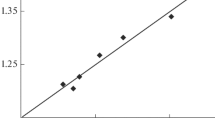Abstract
Concentration dependences of elastooptic coefficients of lead — bismuth — germanate glasses with compositions from virtually the entire range of glass formation in the system PbO — Bi2O3 — GeO2 are investigated. Partial elastooptic coefficients of the oxide ingredients of the investigated glasses are determined. The results are interpreted with consideration of the nature of the elastooptic interaction in glasses subjected to uniaxial stress. The data can be used for designing compositions of optical media for the light and acoustic lines of acoustooptical devices.
Similar content being viewed by others
References
V. V. Kludzin, S. V. Kulakov, and B. P. Razzhivin, “The possibility of application of dense flints for ultrasound light modulation,”Opt.-Mekh. Prom., No. 1, 3–6 (1972).
V. I. Fedelesh, Ya. P. Kutsenko, I. D. Turyanitsa, et al., “Elastooptic characteristics of glasses of the Bi2O3 - GeO2 system,”Fiz. Kkim. Stekla,9(2), 247–248 (1983).
I. I. Zubrinov, B. M. Kopermas, Ya. P. Kutsenko, et. al., “Photoelasticity of glasses of the Pb - Bi - Ge - O system,”Akust. Zh.,24(4), 616–618 (1978).
V. F. Glushkov and D. V. Sheloput, “ Photoelastic properties and the nature of chemical bonding of acoustooptical materials,”Izv. Akad Nauk. SSSR, Ser. Neorg. Mat.,9(9), 1600–1603 (1973).
A. I. Rabukhin and M. M. Smirnova, “Elastooptic properties of germanate glasses containing lead and bismuth,”Tr. Inst. MKhTID. I. Mendeleeva, No. 146, 51–55 (1987).
S. S. Kasymova, S. P. Lun'kin, and E. M. Milyukov, “The region of glass formation and the optical properties of glasses in the system PbO-Bi2O3-GeO2,”Fiz. Khim. Stekla,2(6), 503–506 (1976).
H. Mueller, “Theory of photoelasticity in amorphous solids,”Physics,6(6), 179–184 (1935).
I. G. Zedginidze,Design of Experiments for Investigations of Multicomponent Systems [in Russian], Nauka, Moscow (1976).
A. I. Rabukhin, “Photoelastic constants of germanate glasses containing lead and bismuth oxides,”Steklo Keram., Nos. 11–12, 15–18 (1994).
A. I. Rabukhin and M. M. Smirnova, “Calculating the density and the refractive index of germanate glasses containing lead and bismuth oxides with allowance for their specific structural features,”Tr. 1st. MKhTI D. I. Mendeleeva, No. 142, 30–38 (1986).
A. I. Rabukhin and M. M. Smirnova, “Elastic properties of germanate glasses containing lead and bismuth oxides,”Izv. Vuzov Ser. Khimiya Khim. Tekhnol.,30(3), 85–87 (1987).
W. D. Kingery,Introduction to Ceramics [Russian translation], Stroiizdat, Moscow (1964).
G. I. Epifanov,Solid State Physics [in Russian], Vysshaya Shkola, Moscow (1965).
Author information
Authors and Affiliations
Additional information
Translated from Steklo i Keramika, No. 4, pp. 11–14, April, 1995.
Rights and permissions
About this article
Cite this article
Rabukhin, A.I. Concentration dependences of elastooptic coefficients of germanate glasses containing lead and bismuth oxides. Glass Ceram 52, 87–90 (1995). https://doi.org/10.1007/BF00678698
Issue Date:
DOI: https://doi.org/10.1007/BF00678698




